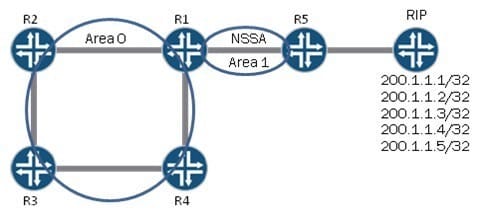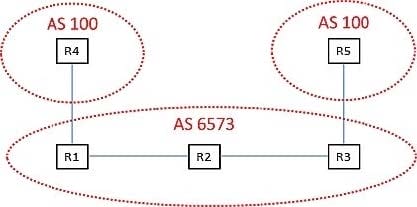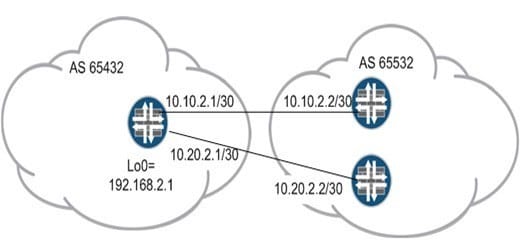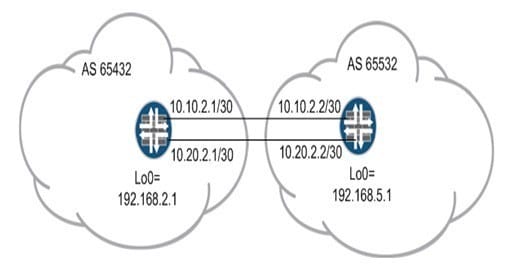Exam Details
Exam Code
:JN0-643Exam Name
:Enterprise Routing and Switching, Professional (JNCIP-ENT)Certification
:Juniper CertificationsVendor
:JuniperTotal Questions
:287 Q&AsLast Updated
:Mar 24, 2025
Juniper Juniper Certifications JN0-643 Questions & Answers
-
Question 91:
-- Exhibit -
OSPF database, Area 0.0.0.0 Type ID Adv Rtr Seq Age Opt Cksum Len Router *10.0.3.4 10.0.3.4 0x8000000d 30 0x22 0x8d11 132 bits 0x0, link count 9 id 10.1.1.0, data 255.255.255.0, Type Stub (3) Topology count: 0, Default metriC. 1 id 10.0.4.8, data 255.255.255.252, Type Stub (3) Topology count: 0, Default metriC. 1 id 10.0.2.10, data 10.0.2.10, Type Transit (2) Topology count: 0, Default metriC. 1 id 172.16.0.6, data 172.16.0.5, Type Transit (2) Topology count: 0, Default metriC. 1 id 10.0.3.4, data 255.255.255.255, Type Stub (3) Topology count: 0, Default metriC. 0 id 10.0.9.7, data 10.0.2.18, Type PointToPoint (1) Topology count: 0, Default metriC. 65 id 10.0.2.16, data 255.255.255.252, Type Stub (3) Topology count: 0, Default metriC. 65 id 10.0.3.3, data 10.0.2.6, Type PointToPoint (1) Topology count: 0, Default metriC. 2 id 10.0.2.4, data 255.255.255.252, Type Stub (3) Topology count: 0, Default metriC. 2 Topology default (ID 0) TypE. PointToPoint, Node ID. 10.0.3.3 MetriC. 2, Bidirectional TypE. PointToPoint, Node ID. 10.0.9.7 MetriC. 65, Bidirectional TypE. Transit, Node ID. 172.16.0.6 MetriC. 1, Bidirectional TypE. Transit, Node ID. 10.0.2.10 MetriC. 1, Bidirectional -- Exhibit -
Click the Exhibit button.
The exhibit shows the output of an OSPF router LSA.
Which interface ID represents the router's loopback address?
A. ID 10.1.1.0
B. ID 10.0.3.4
C. ID 10.0.3.3
D. ID 10.0.2.4
-
Question 92:
-- Exhibit -
user@RP> show pim join extensive InstancE. PIM.master Family: INET R = Rendezvous Point Tree, S = Sparse, W = Wildcard
Group: 224.1.1.1 SourcE. * RP: 192.168.1.1 Flags: sparse,rptree,wildcard Upstream interfacE. Local Upstream neighbor: Local Upstream statE. Local RP Downstream neighbors: InterfacE. so-0/0/0.0
10.0.1.2 StatE. Join Flags: SRW Timeout: 176
Group: 224.1.1.1 SourcE. 10.0.5.2 Flags: sparse,spt Upstream interfacE. unknown (no nexthop) Upstream neighbor: unknown Upstream statE. Local RP Keepalive timeout: 106 Downstream neighbors: InterfacE. so-0/0/0.0
10.0.1.2 StatE. Join Flags: S Timeout: 176
InstancE. PIM.master Family: INET6 R = Rendezvous Point Tree, S = Sparse, W = Wildcard -- Exhibit -
Click the Exhibit button.
The CLI output shown in the exhibit was taken from the RP in a PIM-SM network.
Which statement explains the output shown in the exhibit?
A. No tunnel PIC is installed on the RP router.
B. 192.168.1.1 is not a local IP address on the RP router.
C. Multicast traffic is arriving on the so-0/0/0.0 interface.
D. The router does not have a unicast route to 10.0.5.2.
-
Question 93:
-- Exhibit -
user@SwitchA> show dot1x interface detail ge-0/0/2.0 ge-0/0/2.0 RolE. Authenticator
Administrative statE. Auto
Supplicant modE. Multiple
Number of retries: 3
Quiet perioD. 60 seconds
Transmit perioD. 30 seconds
Mac Radius: Enabled
Mac Radius Restrict: Enabled
Reauthentication: Enabled
Configured Reauthentication interval: 3600 seconds
Supplicant timeout: 30 seconds
Server timeout: 30 seconds
Maximum EAPOL requests: 2
Guest VLAN member:
Number of connected supplicants: 2
user@SwitchA>
-- Exhibit -
Click the Exhibit button.
Host 1, Host 2, and Host 3 are connected to Switch A on interface ge-0/0/2. Host 1 and Host 2 do not support 802.1X. They can authenticate and connect to the Internet. Host 3 was added and it supports 802.1X; however, it is unable to
authenticate.
Referring to the exhibit, how do you allow Host 3 to authenticate to the network but maintain secure access?
A. Enable fallback authentication for 802.1X.
B. Disable MAC RADIUS Restrict option on ge-0/0/2.
C. Disable MAC RADIUS option on ge-0/0/2.
D. Enable Administrative mode for 802.1X.
-
Question 94:
-- Exhibit -
user@router> show bgp summary Groups: 3 Peers: 3 Down peers: 0 Table Tot Paths Act Paths Suppressed History Damp State Pending inet.0 10 8 0 0 0 0 inet6.0 4 3 0 0 0 0 Peer AS InPkt OutPkt OutQ Flaps Last Up/Dwn State| #Active/Received/Accepted/Damped...
10.0.3.5 65550 41 52 0 2 17:45 5/5/5/0 0/0/0/0
172.16.0.6 65010 52 42 0 2 31 Establ inet.0: 3/5/5/0 inet6.0: 3/4/4/0 2001:ffff::3:5 65550 43 44 0 4 17:53 Establ inet6.0: 0/0/0/0
user@router>
-- Exhibit -Click the Exhibit button.
Examine the output of the show bgp summary command shown in the exhibit.
From which BGP peer is the router receiving IPv6 routes?
A. 10.0.3.5
B. 172.16.0.6
C. 2001:ffff::3:5
D. 2001:ffff:3:5
-
Question 95:
-- Exhibit

-- Exhibit -
Click the Exhibit button.
In the exhibit, R5 is receiving five 200.1.1.x routes from the RIP router, and is advertising them into Area 1 using an export policy. You want to summarize the RIP routes into Area 0 with the most specific prefix.
Which configuration will accomplish goal?
A. [edit protocols] user@R1# show ospf { area 0.0.0.0 { area-range 200.1.1.0/29; interface ge-0/0/1.0; interface ge-0/0/2.0; interface lo0.0; } area 0.0.0.1 { nssa { default-lsa type-7; } interface ge-0/0/3.0; } }
B. [edit protocols] user@R1# show ospf { area 0.0.0.0 { interface ge-0/0/1.0; interface ge-0/0/2.0; interface lo0.0;
}
area 0.0.0.1 {
nssa {
default-lsa type-7;
area-range 200.1.1.0/28;
}
interface ge-0/0/3.0;
}
}
C. [edit protocols] user@R1# show ospf { area 0.0.0.0 { interface ge-0/0/1.0; interface ge-0/0/2.0; interface lo0.0; } area 0.0.0.1 { nssa { default-lsa type-7; area-range 200.1.1.0/29; } interface ge-0/0/3.0; } }
D. [edit protocols] user@R1# show ospf { area 0.0.0.0 { area-range 200.1.1.0/28; interface ge-0/0/1.0; interface ge-0/0/2.0; interface lo0.0; } area 0.0.0.1 { nssa { default-lsa type-7; } interface ge-0/0/3.0; } }
-
Question 96:
-- Exhibit

-- Exhibit -Click the Exhibit button.
You are asked to configure an OSPF virtual link that connects remote Area 4 to the backbone.
Referring to the exhibit, what are two requirements for an OSPF virtual link to operate correctly? (Choose two.)
A. A virtual link configuration on the ABR between Areas 0 and 1 must include transit area 1.
B. The interface of the transit area must be of type vt.
C. A virtual link configuration on the ABR between Areas 0 and 1 must be the interface address of the neighbor on the far end.
D. A virtual link configuration on the ABR between Areas 0 and 1 must be the router ID (RID) of the neighbor on the far end.
-
Question 97:
-- Exhibit

-- Exhibit -Click the Exhibit button.
Referring to the exhibit, R4 in AS 100 is sending routes 20.0.0.0/8 and 10.0.0.0/8. R3 sees the routes but R5 does not.
What must be configured on the R3 router for the R5 router to install the routes?
A. a next-hop self policy
B. as-override toward the R5 router
C. as-loops 2
D. local-as 100
-
Question 98:
-- Exhibit

-- Exhibit -Click the Exhibit button.
In the exhibit, R5 is receiving five 200.1.1.x routes from the RIP router, and is advertising them into Area 1 using an export policy. You do not want any of the RIP routes to be in the routing table of R1.
Which two solutions meet this requirement? (Choose two.)
A. On R1, configure an export policy to reject the routes.
B. On R1, configure an import policy to reject the routes.
C. On R1, configure each address as a martian route.
D. On R1, configure the no-nssa-abr option.
-
Question 99:
-- Exhibit

-- Exhibit -Click the Exhibit button.
In the exhibit, a customer wants to configure an EBGP connection to two different routers in a neighboring autonomous system. The goal of this configuration is to use per-prefix load balancing across both EBGP links.
Which configuration accomplishes this goal?
A. {master:0}[edit] user@router# show protocols bgp group External { multihop; peer-as 65532; neighbor 10.10.2.2; neighbor 10.20.2.2; }
B. {master:0}[edit] user@router# show protocols bgp group External { multipath; peer-as 65532; neighbor 10.10.2.2; neighbor 10.20.2.2; }
C. {master:0}[edit] user@router# show protocols bgp group External { multihop; local-address 192.168.2.1; peer-as 65532; neighbor 10.10.2.2; neighbor 10.20.2.2; } user@router# show routing-options static { route 0.0.0.0 next-hop [ 10.10.2.2 10.20.2.2 ]; } autonomous-system 65432;
D. {master:0}[edit] user@router# show protocols bgp group External { multihop; local-address 192.168.2.1; peer-as 65532; multipath; neighbor 10.10.2.2; neighbor 10.20.2.2; } user@router# show routing-options static { route 0.0.0.0 next-hop [ 10.10.2.2 10.20.2.2 ]; } autonomous-system 65432;
-
Question 100:
-- Exhibit

-- Exhibit -
Click the Exhibit button.
A customer is trying to configure a router to peer using EBGP to a neighbor. As shown in the exhibit, two links are being used for this configuration. The goal of this configuration is to load- balance traffic across both EBGP links.
Which configuration accomplishes this goal?
A. {master:0}[edit] user@router# show protocols bgp group External { multihop; local-address 192.168.2.1; peer-as 65532; neighbor 10.10.2.2; neighbor 10.20.2.2; } {master:0}[edit] user@router# show routing-options static { route 192.168.5.1/32 next-hop 192.168.2.1; } autonomous-system 65432;
B. {master:0}[edit] user@router# show protocols bgp group External { multihop; local-address 192.168.2.1; peer-as 65532; neighbor 192.168.5.1; } {master:0}[edit] user@router# show routing-options static { route 192.168.5.1/32 next-hop [ 10.10.2.2 10.20.2.2 ]; } autonomous-system 65432; forwarding-table { export load-balance; } {master:0}[edit] user@router# show policy-options policy-statement load-balance term balance { then { load-balance per-packet; accept; } }
C. {master:0}[edit] user@router# show protocols bgp group External { multi-path; local-address 192.168.2.1;
peer-as 65532;
neighbor 192.168.5.1;
}
{master:0}[edit]
user@router# show routing-options
static {
route 192.168.5.1/32 next-hop [ 10.10.2.2 10.20.2.2 ]; }
autonomous-system 65432;
D. {master:0}[edit] user@router# show protocols bgp group External { multipath; local-address 192.168.2.1; peer-as 65532; neighbor 10.10.2.2; neighbor 10.20.2.2; } {master:0}[edit] user@router# show routing-options static { route 192.168.5.1/32 next-hop 192.168.2.1; } autonomous-system 65432;
Related Exams:
JN0-102
Internet Associate, Junos(JNCIA-Junos)JN0-104
Junos, Associate (JNCIA-Junos)JN0-105
Junos, Associate (JNCIA-Junos)JN0-1101
Juniper Networks Certified Design Associate (JNCDA)JN0-130
Juniper networks Certified internet specialist.e(jncis-e)JN0-1301
Data Center Design, Specialist (JNCDS-DC)JN0-1302
Data Center Design Specialist (JNCDS-DC)JN0-1331
Security Design, Specialist (JNCDS-SEC)JN0-1332
Security Design, Specialist (JNCDS-SEC)JN0-1361
Service Provider Design Specialist (JNCDS-SP)
Tips on How to Prepare for the Exams
Nowadays, the certification exams become more and more important and required by more and more enterprises when applying for a job. But how to prepare for the exam effectively? How to prepare for the exam in a short time with less efforts? How to get a ideal result and how to find the most reliable resources? Here on Vcedump.com, you will find all the answers. Vcedump.com provide not only Juniper exam questions, answers and explanations but also complete assistance on your exam preparation and certification application. If you are confused on your JN0-643 exam preparations and Juniper certification application, do not hesitate to visit our Vcedump.com to find your solutions here.